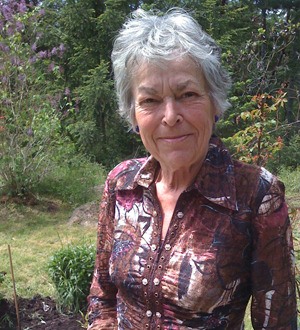On a rainy Sunday afternoon, about a month before she died, Betsy Roberts trudged along West Side Road, moving purposefully “to see a friend” she told me, as she accepted an offer of a ride northbound toward Roche Harbor.
She was wary until I told her I was a reporter with the Journal of the San Juan Islands, then she talked almost non-stop for the half-hour ride.
“You might be interested that I was the foreman on the Ruth Neslund trial,” she said, starting a quick-paced monologue that had me wishing I had my voice recorder with me.
Interlaced with comments about her 30 years living on San Juan Island, a place she said she dearly loved, she admitted her jury service was an important episode of her life, but she wanted me to know there was more to her than that trial.
She told me she read, and wrote, “a lot.” I asked what she read; she said, “Mostly history, especially medieval history, which I studied in college and love.” She was also a fan of Winston Churchill, she said, and named a restaurant in Friday Harbor “Winston’s”.
Without being asked, she said, “Ruth Neslund did it, but I felt for her.” Roberts was quoted in Ann Rule’s book saying, “It was not a decision we wanted to come up with. But the evidence was too much. It was a difficult case for all of us.”
We had driven along West Side Road, Mitchell Bay Road and West Valley Road to the Roche Harbor Road corner. She abruptly said, “Let me out here; this is close enough.” I said I wanted to talk more about the Neslund trial; she pulled her business card (“Betsy Roberts, Certified Residential Appraiser”) out of her bag and said, “Call me; I’ll talk more.”
When I tried the number a few weeks later, the phone had been disconnected. She had died.
Talking to her friends and her only child, Oren Wool, I learned that there was indeed much more about Betsy Roberts than her participation on the Neslund trial. “It was a wild ride with her, she attracted people to her,” said her son, who is Executive Director of the Sustainable Enterprise Conference in Santa Rosa, Calif.
Betsy was born Elizabeth Ann Roberts in California in 1943, graduated from Glendale High School, and attended UC Berkeley in the ’60s – until she was expelled for participating in the demonstrations and campus occupation of Sproul Hall, led by Mario Savio, Joan Baez and others. She’s survived by two sisters, one brother and two former husbands.
She considered herself part of the Jack Kerouak/Allen Ginsberg “beat generation” – but she liked the University of Alabama, from which she graduated with a degree in history in 1978. And she liked clothes (“always looked great,” said a friend), traveling (she was a TWA stewardess and ticket agent who used her travel bonus extensively) and Jerry Garcia.
In 1980, she came to Friday Harbor with her then-husband Dale Blackburn. She designed the house on Bailer Hill Road that she lived in for the rest of her life. She was active in the Animal Protection Society, the theatre, the library and the Democratic Party.
Greg Canova, brought in from the Attorney General’s office to prosecute Ruth Neslund for first-degree murder, remembers Roberts and the trial.
“It was the hardest case I ever tried,” said Canova, now a superior court judge in King County. “Presiding juror requires multiple personal and analytical skills, and patience. She did an exceptional job and kept all jurors fully involved, and brought in a verdict in less than a week.”
Charlie Silverman, San Juan County Deputy Criminal Prosecutor, who was co-prosecutor in the Neslund trial, said he knew Betsy more from working with her on the local Democratic steering committee.
“She was progressive, feisty and had good ideas,” Silverman said. “Against the Iraq war and the first person I knew who said something was wrong with the housing market. About 2004 or 2005, she told me and the local Democrats that no-down, variable rate mortgages and the inflated housing market were going to get ordinary people into trouble. She was right, as we have seen.”
Jeanne Barnes (now Leone) served on the Neslund jury with Roberts.
“She did a very good job, kept the discussion on the subject and would smooth things over when people started to get unhappy. She was capable and even-handed and intelligent. None of the jurors had any complaints about her.”
Leone’s sister in law, Andrea Bogen, met “Bets” soon after Roberts arrived in Friday Harbor in 1980.
“An admirable, amazing woman,” said Bogen, “we loved her a lot. She just knew how to do everything right, though sometimes she could be difficult, even hard to like, especially the last few years. What an entertainer. She gave great parties, cooked wonderful dinners.
“Her Christmas decorations and her gardening were always outstanding—when I first went in the early 80s she actually had real candles on the tree. She was a good friend, active with the library, animal rescue, and helped in the garden at the Mullis Center. She actually gave tea parties—with hats. And she was a fan of Jerry Garcia, whom she said she had met.”
If Betsy Roberts had a theme song, it might have been Edith Piaf’s “No Regrets”, which was also the title of Anne Rule’s book about the trial. She was the kind of person you wish you had known better, and earlier.




